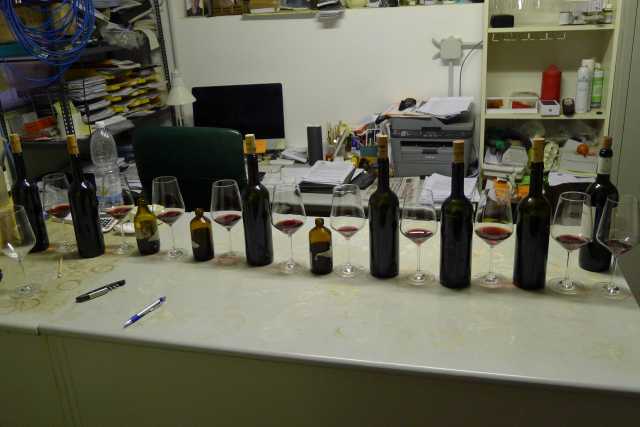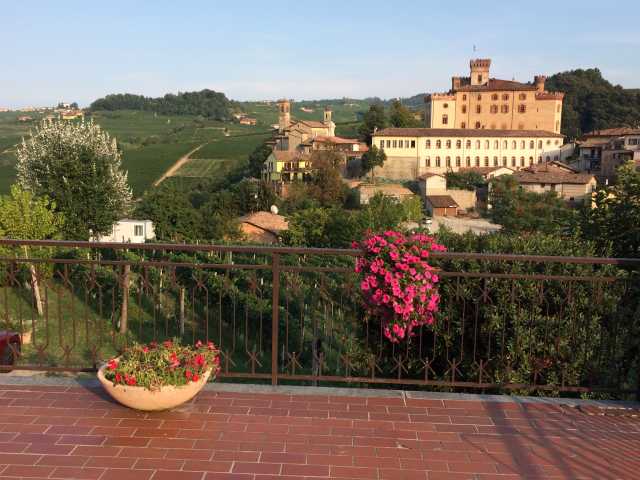It’s the season for posting notes on one’s summer visit to Piemonte, so here are mine, which complement Howard Davis’s and Daniel Moritz’s threads here and Ken Vastola’s blog posts from his visit in July.
My approach: I spend six days in Barolo and Barbaresco the weeks of Aug. 29 and Sept. 8. This was my ninth visit to the region over 20 years. Each time I aim to visit a few headliners, but I’m just as interested to taste with up-and-coming winemakers and those that offer good value.
On my first visits in 1996 and 1997, I visited a lot of producers in the modern camp – Scavino, Azelia, di Gressy. Over time, I found I preferred more traditionally made wines and this year’s line-up reflects that bias. I tasted at Germano (Serralunga), Brezza (Barolo), Burlotto (Verduno), Fratelli Alessandria (Verduno), Cogno (Barolo), Vajra (Barolo), Rizzi (Treiso) and Cortese (Barbaresco). Note: Germano was the only place I tasted at on the Serralunga/Monforte side of the Barolo appellation; the others are all toward the west and north or in Barbaresco.
Weather: A powerful thunderstorm was moving in when I arrived at the Hotel Barolo Monday night, Aug.29. There were stars overhead but lightening ringing the distant hills as I dined on the hotel terrace at 10 pm. Soon, the storm hit Barolo itself, with heavy rain over night and showers off and on on Tuesday. The winemakers said it was beneficial – it was a dry summer and it had been unusually hot the week before and the vines were dry. The rain also slowed down maturation, which was moving a bit quicker than they preferred. It was cooler, less humid and breezy for two days after the rain, so the vines quickly dried off. Overall it was somewhat warmer than usual over the ten days I was there – mid-80s Fahrenheit/30C-ish – but the nights were pleasant, generally in the high 60Fs/20C-ish.
Bottling: Bottling was underway that week. I assumed that was due to the impending harvest of the whites and the need to empty out their tanks. But several winemakers said the timing was dictated by a new moon. Fabio Alessandria at Burlotto said that the biological activity is slower under new moons, so the wines may age better if they’re put in the bottle at that point.
I’ll put my tasting notes in separate posts to make it easier to quote and respond. Before I get to those, here are some takeaways:
• There are scads of good wines hitting the market or in the pipeline from the 2011-15 vintages at all levels, from barbera and simpler nebbiolos to Barolo and Barbaresco, and 2016 looks very promising. So I don’t see it as a do-or-die/vintage-of-the-era time from a buying standpoint. But then I take the general view that no single wine is indispensable.
• I had a hard time getting a good take on the vintages because I was not able to taste across vintages of the same wine except in a few places and the winemakers seemed reluctant to give decisive characterizations. By one measure – how many riservas will be made – 2011, 2013 and 2015 are the stronger vintages. But as I said in the separate thread I started on the 2012s, there’s a lot to be said for ‘12s.
o 2011: Ripe, full in the mouth. Maybe a tad less acid than I’d like, but that’s a matter of preference.
o 2012: Elegant, less powerful but with great perfume. To me this was a Burgundy-lover’s vintage. All the producers I spoke with were very positive about the way the wines have turned out. But cf. Greg dal Piaz’s takedown of the vintage.
o 2013: Powerful, rich. Fabio Alessandria at Burlotto described it as being like a cross of the ripeness of 09 with the finesse of 12. Cortese’s 2013 Rabaja has sold out, in part because of the quality and in part because a quarter or a third of the production is going to a riserva.
o 2014: Problematic because of rains shortly before the barbera and dolcetto were harvested and hail in Barolo. More successful for nebbiolo, which ripens later. No one is talking up the vintage, but I tasted a number of very good wines (e.g., Cogno barbera; Brezza Nebbiolo d’Alba; Germano dolcetto; Rizzi’s barbera and dolcetto). Barbaresco did not have hail and the Produttori di Barbaresco will bottle their crus in 2014. So it’s not a simple story for the vintage.
o 2015: A year for big wines. Winemakers said the growing conditions were near perfect, and the barberas, dolcettos and nebbiolos I had were very good.
o 2016: Through last week, conditions again had been ideal and the winemakers are very optimistic.
o I noted that there were 2009s and even some 2007s on store shelves, but no 2008s or 2010s. The 2010s sold out at the wineries very quickly in most cases.
• Don’t overlook the normale/classico bottlings or other blends that are lower priced than the crus. Oddero’s classico and Burlotto’s Acclivi were outstanding in 2012, I thought. Oddero sees theirs not as a lesser wine but simply following the older tradition of blending vineyards, in part because some of their parcels (e.g., Fiasco) aren’t big enough to bottle separately.
• The oddball bottlings such as nascetta (indigenous white), pelaverga (indigenous pale red), riesling (Germano and Vajra) and sparkling wines (including those from nebbiolo, like one of Germano’s) offer some very interesting drinking.
A few other wine observations:
• The Asian market is becoming much more important. Danielle Cortese said that sales to all parts of Asia now equal the U.S. and Canadian sales for him. So Asian buyers are not just trophy-hunting for Gaja and Giacosa (the usual stereotype).
• I was struck by the number of sickly individual vines in Barbaresco compared to Barolo where I had been struck by how perfectly green and healthy the vines were – scarcely a leaf had turned color. I’m not sure if weak vines reflect a lack of care or lower prices for Barbaaresco or a bit of both. At the same time, there is a great deal of replanting in Barbaresco. On most slopes, you can see at least one swath that has been torn up and is barren at the moment – something that is rare in the Barolo zone. Looking southwest from Rizzi’s cantina in Treiso, for instance, there are a series of bald, plowed plots across the valley. Enrico Dellapiano at Rizzi told me that someone bought much of that ridge and has torn up old barbera and dolcetto as well as fruit trees and is replanting, partly with nebbiolo.
The scale of the replanting should bode well for Barbaresco over the longer haul, once the vines mature.
Two non-wine observations:
• Bleached blond has gone out of fashion among Italian women. This is good.
• Italy has discovered speed bumps. This is a pity. But, what the hell, it’s a rental car.


